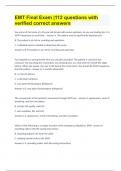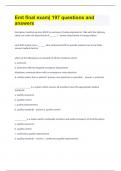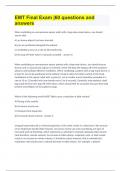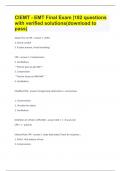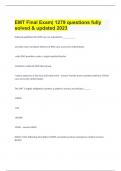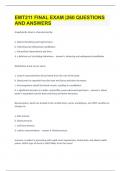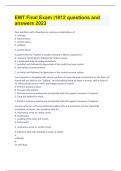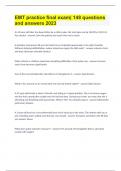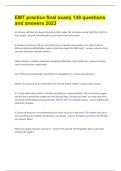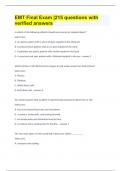LINDSEY WILSON COLLEGE
Latest uploads at LINDSEY WILSON COLLEGE. Looking for notes at LINDSEY WILSON COLLEGE? We have lots of notes, study guides and study notes available for your school.
-
26
- 0
-
3
All courses for LINDSEY WILSON COLLEGE
Latest notes & summaries LINDSEY WILSON COLLEGE
You arrive at the home of a 50-year-old female with severe epistaxis. As you are treating her, it is MOST important to recall that: A. The patient may be significantly hypertensive. B. The patient is at risk for vomiting and aspiration C. A detailed exam is needed to determine the cause Answer is B. The patient is at risk for vomiting and aspersion You respond to a young female who was sexually assaulted. The patient is conscious but confused. The last thing she remembers was drinking...
Emergency medical services (EMS) as we know it today originated in 1966 with the highway safety act under the department of______? department of transportation each EMS system has a ______ who authorizes EMTs to provide medical care in the field. medical director which of the following is an example of off-line medical control. a. protocols b. telemetry with the hospital emergency department telephone communications with an emergency room physician d. written orders from a pa...
When ventilating an unresponsive apneic adult with a bag-valve-mask device, you should ensure that: A) an airway adjunct has been inserted. B) you are positioned alongside the patient. C) ventilations occur at a rate of 20 breaths/min. D) the pop-off relief valve is manually occluded. A When ventilating an unresponsive apneic patient with a bag-mask device, you should ensure that an oral or nasal airway adjunct is inserted, which will keep the tongue off of the posterior pharynx and faci...
Steps Prior to CPR 1. AVPU 2. Check carotid! 3. If pulse present, check breathing! CPR 1. Compressions 2. Ventilations *Partner goes to get AED* 3. Compression *Partner drops an OPA/NPA* 4. Ventilations Modified CPR Foreign body obstruction + unconscious 1. Compressions 2. Visualize for object 3. Ventilations Definition of a Peds in CPR/AED AED = 1 - 8 years old CPR = 1 - puberty Infants/Peds CPR 1. Baby baby baby! Check for response... 2. AVPU - fl...
National guidelines for EMS care are intended to __________. -provide more consistent delivery of EMS care across the United States -unify EMS providers under a single medical director -facilitate a national EMS labor group -reduce expenses at the local and state levels Provide more consistent delivery of EMS care across the United States The EMT is legally obligated to protect a patient's privacy according to _____. -HIPAA -CQI -APGAR -DCAP HIPAA Which o...
Anaphylactic shock is characterized by: a. labored breathing and hypertension. b. wheezing and widespread vasodilation. c. intracellular hypovolemia and hives. d. a deficiency of circulating histamines. b. wheezing and widespread vasodilation Distributive shock occurs when: a. central vasoconstriction forces blood from the core of the body. b. blood pools in expanded vascular beds and tissue perfusion decreases. c. microorganisms attack the blood vessels, resulting in vasodila...
Poor nutrition and GI bleeding are common complications of: A. syncope. B. hypertension. C. alcohol abuse. D. epilepsy. C. alcohol abuse. A patient who has "huffed" a volatile chemical is likely to experience: A. visionary hallucinations followed by violent nausea. B. a prolonged state of profound euphoria. C. an initial rush followed by depression of the central nervous system. D. immediate unconsciousness. C. an initial rush followed by depression of the central nervo...
An 18 year old hiker has been bitten by a rattle snake. His vital signs are bp 140/90 p 130 R 24. You should: Calm the patient and coach him not to move A pulseless and apneic 68 year old male has an implanted pacemaker in his right shoulder Without delaying defibrillation, where should you apply the AED pads? anterior chest and back (between shoulder blades) When infants or children experience breathing difficulties, their pulse may Increase early, then decrease significantly ...
When assessing a conscious patient who overdosed on a drug, you should FIRST determine: A) the patient's weight in kg. B) the type of medication ingested. C) when the medication was ingested. D) if there is a history of prior overdose. B While triaging patients at a mass-casualty incident, you encounter a 4-year-old child who is breathing at a rate of 54 breaths/min. What should you do? A) Apply high-flow oxygen B) Tag the child as immediate C) Assess for distal pulses D) Ventil...
In which of the following patients should you remove an impaled object? Select one: A. An apneic patient with a shard of glass impaled in the abdomen B. A semiconscious patient with an ice pick impaled in the chest C. A pulseless and apneic patient with a knife impaled in the back D. A conscious and alert patient with a fishhook impaled in the eye C Which portion of the blood carries oxygen to and wastes away from body tissues? Select one: A. Plasma B. Platelets C. White blood c...

